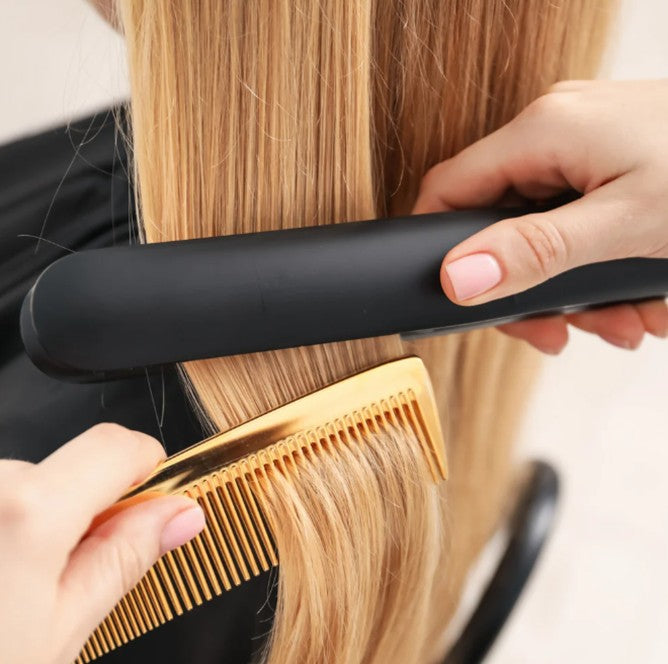How To Read Hair Labels Like A True Pro
by HEATHER COLLIER / OCT 14, 2025

Reading Time: 4 Minutes
Index
Standing in the haircare aisle can feel like navigating a maze. In a sea of buzzwords and complex ingredient lists, every bottle promises miracles, yet the fine print often hides what’s really inside. Learning to read hair product labels is one of the most empowering things you can do for your hair. Once you know how to decode the language of ingredients, you’ll be able to choose products that genuinely suit your hair type and goals – not just the ones with the prettiest packaging.
The secret is understanding that not all ingredients are ever the same, and their order on the label tells a crucial story for your locks. By learning a few key principles, you’ll quickly start spotting the good, the bad, and the marketing fluff. Here's our guide of on how to read haircare labels like a pro so you can give your hair and hair extensions the TLC they deserve:
The Power of the First Five Ingredients

When you pick up a new shampoo or conditioner, the first few ingredients reveal the bulk of the formula. Ingredients on cosmetic labels are always listed in descending order of concentration, which means the first five or six make up most of what’s inside. For example, if you see “Aqua” or “Water” at the top, that’s your base. After that, look for what comes next, as these ingredients are the real drivers of performance, whether that’s hydration, repair, or something else.
If the label is front-loaded with nourishing elements like coconut oil, glycerine, or aloe vera, that’s a good sign. But if it’s dominated by harsh detergents or heavy silicones, you might be looking at a product that gives instant shine but long-term build-up.
Understanding Key Ingredients

Let’s talk about what these ingredients actually mean for your hair. Sulphates, are powerful cleansers that create that satisfying lather. However, they can also strip away your hair’s natural oils, leaving it dry or frizzy, especially if it’s coloured, curly, or chemically treated.
Silicones, like dimethicone or cyclomethycaine, are common in smoothing and anti-frizz products. They coat the hair shaft, giving a silky finish and adding shine. The catch? Some silicones aren’t water-soluble, so they can build up over time and block moisture from entering the hair. If you prefer that glassy finish, try formulas that use lightweight or water-soluble silicones instead.
Gentle cleansing agents such as cocamidopropyl betaine are kinder alternatives to harsh sulphates. They cleanse effectively without over-drying the scalp. Then there are humectants like glycerine and panthenol, which draw moisture into the hair, and proteins or amino acids that help strengthen strands from within. Oils such as argan, jojoba, or coconut, nourish and smooth the cuticle, adding softness and shine.
It’s also worth paying attention to preservatives and fragrances. Preservatives are essential for keeping your product fresh, but strong ones like parabens or formaldehyde-releasing agents are best kept to a minimum. Similarly, fragrances can make a product smell divine, but too much can irritate sensitive scalps.
If you’re looking for a formula that strengthens your hair and improves its overall appearance, making it strong and shiny enough to endure brushing and styling, then look no further than ingredients such as hydrolysed Oat, Soy, Silk, and Wheat proteins, hydrolysed Keratin, hydrolysed Collagen, and Silk Amino Acids. Before stocking up on bulky protein-based hair products, make sure you evaluate the situation in your hair correctly – as too much of a good thing can actually cause dryness and breakage.
Matching Ingredients to Your Hair Type

Once you understand what’s in your products, you can tailor your choices to what your hair actually needs. If you have fine or oily hair, look for lightweight formulas that cleanse thoroughly without weighing it down. Dry or curly hair tends to crave hydration, so humectants, oils, and gentle cleansers are your best friends. Colour-treated hair benefits from sulphate-free options that preserve vibrancy and reduce fading.
It’s also a good idea to mix things up occasionally. If your go-to shampoo contains silicones or heavier conditioning agents, add a clarifying shampoo to your routine once or twice a month. This helps remove build-up and keeps your hair feeling fresh and responsive to treatments.
Becoming a Smarter Shopper

Decoding a label doesn’t mean you need a degree in chemistry, just a little awareness. Start by glancing at the top few ingredients and checking for what stands out. If something you love, like argan oil or keratin, appears near the end of the list, it’s probably included in a very small amount, more for marketing than for real results. Likewise, if you see a strong cleanser or artificial fragrance right at the top, think twice before buying.
Over time, you’ll develop an instinct for what works for your hair. You’ll start to recognise patterns: certain brands that prioritise natural, nourishing bases, and others that rely more heavily on fillers or cosmetic effects. The more you practice reading labels, the easier it becomes to spot a truly quality product.
Conclusion:
Not every hair type is the same, therefore there isn’t a “one size fits all” hair product to solve every problem. Understanding hair product labels isn’t about memorising every ingredient; it’s about becoming a conscious consumer. By learning to interpret what’s written on the back of the bottle, you take control of what goes on your hair and scalp every week. Focus on products with thoughtful formulations that balance hydration and strength, and always let your hair’s response guide your choices. Once you’ve mastered these tricks, you’ll shop with confidence, and your hair will look and feel healthier for it!
Looking for flawless, salon-worthy hair without breaking the bank? At Cliphair, we’ve got you covered with luxurious clip in hair extensions for quick transformations and permanent hair extensions for long-lasting glam. Extensions require special care and maintenance to preserve their quality, which is why we have all the top-notch hydrating haircare products needed to keep your style on point.
Need the perfect shade? Browse our full range of human hair extensions in over 70 rich, silky shades or check out our FREE Express Color Match Service to ensure a seamless blend every time.






